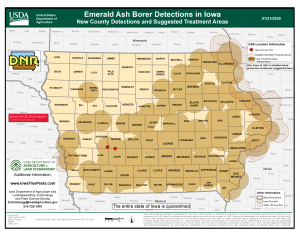EAB confirmed in Audubon & Guthrie Counties
January 23rd, 2020 by Ric Hanson
Officials with the Iowa Department of Agriculture and Land Stewardship report an insect that kills ash trees has been confirmed for the first time, in Audubon and Guthrie Counties. Emerald Ash Borer (EAB) larvae were collected from infested trees in rural Exira and Casey. The invasive, tree-killing pest has been found in 71 Iowa counties since 2010. EAB is a small, metallic-green beetle that attacks and kills ash tree species. In its larval stage, EAB bores beneath the bark disrupting the movement of water and nutrients within the tree. Infested trees typically die within two to four years.
 Ash trees infested with EAB might include canopy thinning, woodpecker damage, water sprouts from the trunk or main branches, serpentine (“S”-shaped) galleries under the bark, vertical bark splitting and 1/8-inch D-shaped exit holes. Mike Kintner, Iowa Department of Agriculture and Land Stewardship EAB coordinator, says “Woodpeckers like to eat EAB larvae beneath the bark of ash trees. Despite it being winter, woodpecker damage is an indicator EAB may be lurking in a tree.” The adult beetle can spread naturally by flying short distances to area host trees; however, the more threatening long-distance spread is by human-assisted movement. Beneath the bark, larvae can unknowingly be transported in infested wood products such as firewood. People are encouraged to use locally-sourced firewood where they are going to burn it.
Ash trees infested with EAB might include canopy thinning, woodpecker damage, water sprouts from the trunk or main branches, serpentine (“S”-shaped) galleries under the bark, vertical bark splitting and 1/8-inch D-shaped exit holes. Mike Kintner, Iowa Department of Agriculture and Land Stewardship EAB coordinator, says “Woodpeckers like to eat EAB larvae beneath the bark of ash trees. Despite it being winter, woodpecker damage is an indicator EAB may be lurking in a tree.” The adult beetle can spread naturally by flying short distances to area host trees; however, the more threatening long-distance spread is by human-assisted movement. Beneath the bark, larvae can unknowingly be transported in infested wood products such as firewood. People are encouraged to use locally-sourced firewood where they are going to burn it.
The entire state of Iowa is under quarantine for EAB. A federal quarantine, enforced by the U.S. Department of Agriculture, prohibits the movement of regulated articles such as living and dead material from ash trees and all hardwood firewood out of Iowa into non-quarantined areas of other states. At this calendar date, the window for all preventive treatments is closed. If a landowner is interested in protecting a valuable and healthy ash tree within 15 miles of a known infestation, he or she should have landscape and tree service companies bid on work, review the bids this winter and begin treating in spring 2020 (early April to mid-May).
To learn more about EAB and to view known locations in Iowa, please visit http://www.iowatreepests.com.





